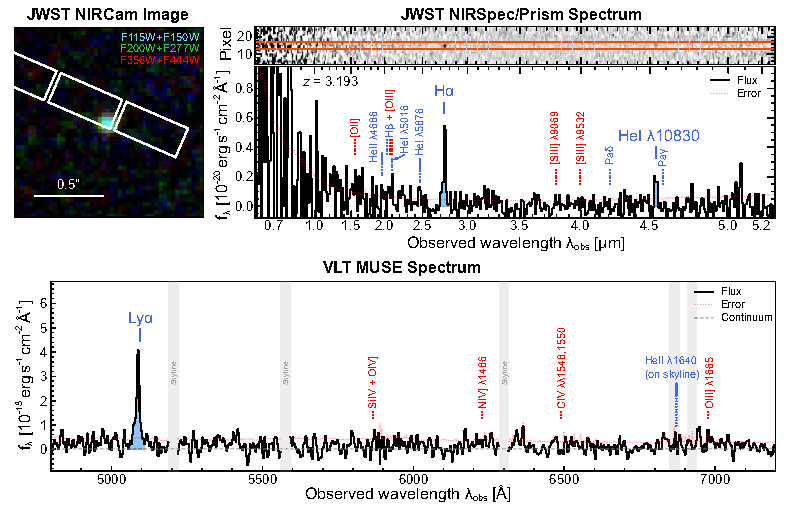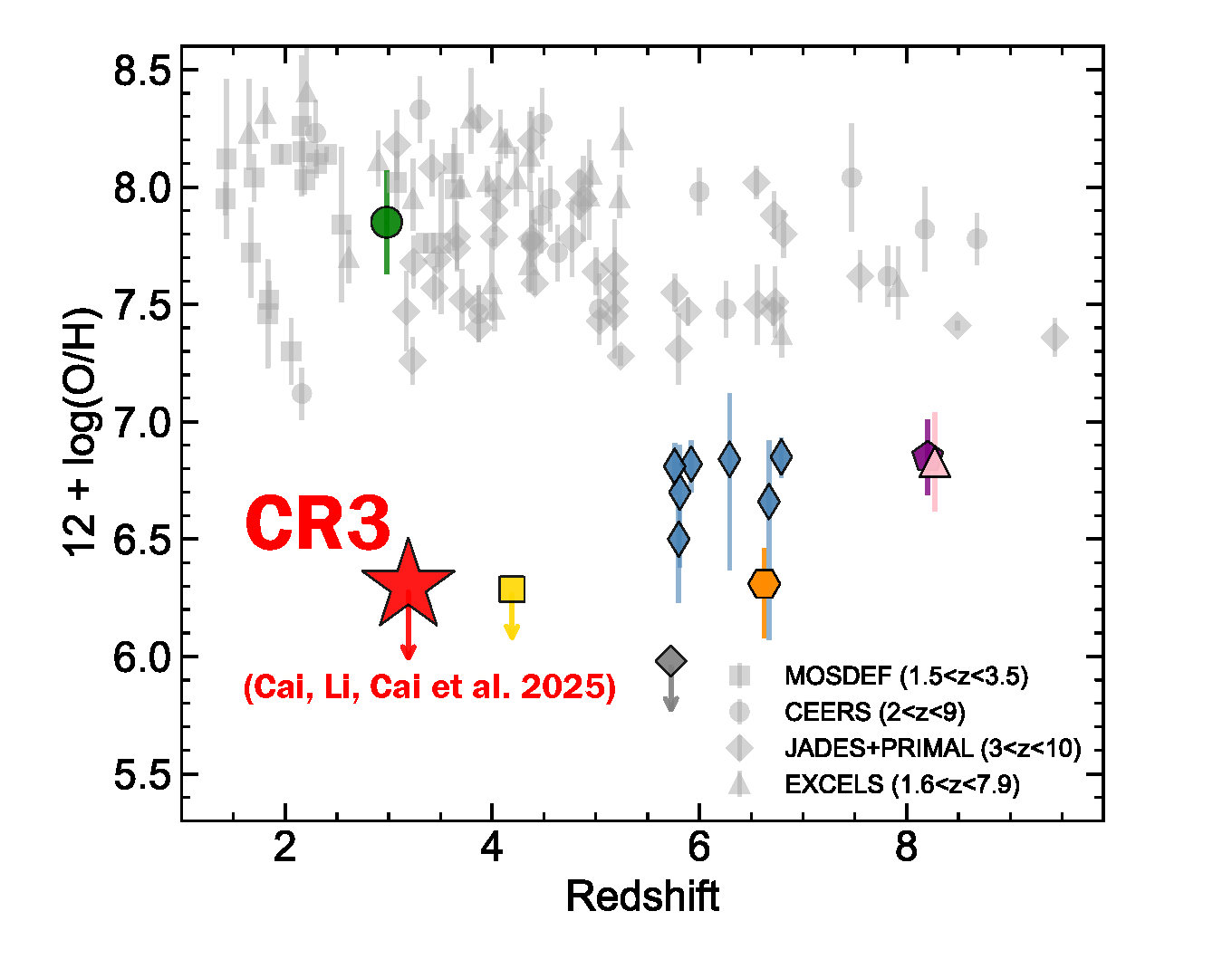Introduction: An international collaboration led by the Department of Astronomy at Tsinghua University has discovered a galaxy extremely poor in metals, suspected to contain "first-generation" stars, by using combined observations from the James Webb Space Telescope (JWST), the Very Large Telescope (VLT), and the Subaru Telescope. The team has named this galaxy "CR3". It is located in the "cosmic noon" period, dating back to approximately 11.5 billion years ago. CR3 is currently the galaxy with the lowest abundance of heavy elements found at "cosmic noon", with an elemental content close to that theoretically predicted for "first-generation galaxies". This discovery is akin to finding a “living fossil” in the middle-aged Universe, suggesting that Population III star formation may have persisted longer than previously believed, and revealing the inhomogeneity and complexity of cosmic chemical enrichment. The results have been published in The Astrophysical Journal Letters (ApJL).
The First Light of the Universe: Tracing Population III Stars
How the first stars in the universe (known as Population III stars) formed and died is a major unsolved mystery in the field of galactic cosmology. The existence of these stars serves as compelling fossil evidence supporting the Big Bang theory. Consequently, uncovering their history remains one of the core scientific objectives of the James Webb Space Telescope's (JWST) mission.
Theoretical studies suggest the host galaxies of the first stars, also termed "first galaxies”, emerged only a few hundred million years after the Big Bang, being composed almost entirely of hydrogen and helium, with extremely high masses, temperatures, and short lifetimes. Because they were metal-free (lacking elements heavier than helium), their host galaxies would show spectra very different from later generations—strong hydrogen and helium recombination lines, but almost no oxygen or other metal lines. However, these objects are both short-lived and extremely distant. Directly detecting the "first galaxies" remains a long-pursued yet unrealized goal for astronomers.
CR3: A Primitive Galaxy Candidate at Cosmic Noon
Conventional models predict that as the Universe evolves, the intergalactic medium (IGM) becomes rapidly enriched with metals from successive supernovae, effectively ending the formation of first-generation stars after the reionization epoch (z ~ 6). Yet, the team has identified an exceptionally pristine galaxy, CR3, at redshift z = 3.19—about 11.5 billion years ago, during cosmic noon. Its spectrum only shows strong hydrogen and helium emission lines, but no detectable metal lines. The galaxy appears almost dust-free, extremely young (≈ 2 million years), and low in mass (≈ 6.1 × 10⁵ M⊙), displaying typical features of a theoretically predicted pristine system. The discovery of CR3 therefore provides observational evidence that Population III star formation may have continued into the cosmic noon epoch, challenging existing popular theoretical frameworks.
Based on current standard abundance calibration methods, CR3 stands out among currently known "cosmic noon" galaxies as the one with the lowest inferred heavy-element abundance.

Figure 1. Image and spectrum of galaxy CR3, presenting the characteristic signatures of a theoretically predicted primordial galaxy. It exhibits only the strong hydrogen and helium emission lines produced by the primordial Big Bang, with no detection of any other heavy-element emission lines.
A Survivor in a Mature Universe: CR3 May Reside in a Quiet Cosmic Neighborhood
Why could such a primitive galaxy exist in a Universe already so evolved? Environmental analysis shows that CR3 lies in a slightly underdense region within the large-scale cosmic environment. The team hypothesizes that in such environments, metal-enriched outflows from nearby galaxies may not have reached CR3, and that galaxy mergers and interactions are relatively rare. This isolation could allow pockets of pristine gas to “survive” until later times, delaying the process of metal enrichment.

Figure 2. CR3 is currently the only known Population III galaxy candidate discovered at the cosmic noon epoch.
Future spectroscopic observations with higher resolution and signal-to-noise ratio will be crucial to confirm the true nature of CR3. Its discovery is expected to motivate the construction of a larger sample of similar first galaxy candidates. Such a sample will provide key observational insights for understanding the history of star formation and the evolutionary processes of galaxies in the early universe.
This study, titled “A Metal-Free Galaxy at z = 3.19? Evidence of Late Population III Star Formation at Cosmic Noon”, has been published in The Astrophysical Journal Letters (ApJL) [https://doi.org/10.3847/2041-8213/ae1608]. The work was led by Sijia Cai, a Ph.D. student at Tsinghua University, as the first author, with Mingyu Li as the second author, and Prof. Zheng Cai as the corresponding author. Yunjing Wu and Fujiang Yu provided data support. Collaborating institutions include NSF’s National Optical-Infrared Astronomy Research Laboratory, Harvard-Smithsonian Center for Astrophysics, Steward Observatory at University of Arizona, Leiden Observatory at Leiden University, Institute for Astronomy at University of Edinburgh, and European Southern Observatory. This work is supported by National Key R&D Program of China and Tsinghua University Initiative Scientific Research Program.

